The Mixed-Layer Structures of Ikunolite, Laitakarite, Joséite-B and Joséite-A
Abstract
1. Introduction
2. Background: The Bi4S3–Bi4Se3–Bi4Te3 Isoseries
3. Microanalytical Methodology
3.1. Electron Probe Microanalysis
3.2. Nanoscale Analysis
4. Results
4.1. Petrography
4.2. Compositional Data
4.3. Nanoscale Characterization
4.3.1. Stacking Sequences in Bi4X3 Phases
- (1)
- qF* = i × dN* = (i × d*)/N leading to:
- (2)
- dN = qF/i and N = (i × qF)/d
4.3.2. Identity of Atoms in the Layers
4.3.3. Nanoscale Inclusions and Lattice-Scale Defects
5. Discussion
5.1. Relationships with Other Phases
5.2. Mixed Sites versus Inclusions: The Role and Location of Lead
6. Conclusions and Implications
Supplementary Materials
Author Contributions
Funding
Data Availability Statement
Acknowledgments
Conflicts of Interest
References
- Cook, N.J.; Ciobanu, C.L.; Wagner, T.; Stanley, C.J. Minerals of the system Bi-Te-Se-S related to the tetradymite archetype: Review of classification and compositional variation. Can. Miner. 2007, 45, 665–708. [Google Scholar] [CrossRef]
- Ciobanu, C.L.; Pring, A.; Cook, N.J.; Self, P.; Jefferson, D.; Dima, G.I.; Melnikov, V. Chemical-structural modularity in the tetradymite group: A HRTEM study. Am. Miner. 2009, 94, 517–534. [Google Scholar] [CrossRef]
- Van Landuyt, J.; De Ridder, R.; Gevers, R.; Amelinckx, S. Diffraction effects due to shear structures: A new method for determining the shear vector. Mater. Res. Bull. 1970, 5, 353–362. [Google Scholar] [CrossRef]
- Imamov, P.M.; Semiletov, S.A. The crystal structure of the phases in the system Bi-Se, Bi-Te, and Sb-Te. Sov. Phys. Crystallogr. 1971, 15, 845–850. [Google Scholar]
- Van Tendeloo, G.; van Dyck, D.; Kuypers, S.; Amelinckx, S. Electron diffraction effects in mixed layer compounds. I. Theorteical considerations. Phys. Stat. Sol. 1989, 101, 339–354. [Google Scholar] [CrossRef]
- Frangis, N.; Kuypers, S.; Manolikas, C.; Van Tendeloo, G.; Amelinckx, S. Continuous series of one-dimensional structures in compounds based on M2X3 (M = Sb, Bi, X = Se, Te). J. Solid State Chem. 1990, 84, 314–334. [Google Scholar] [CrossRef]
- Shelimova, L.E.; Karpinsky, O.G.; Kosyakov, V.I.; Shestakov, V.A.; Zemskov, V.S.; Kuznetsov, F.A. Homologous series of layered tetradymite-like compounds in Bi-Te and GeTe-Bi2Te3 systems. J. Struct. Chem. 2000, 41, 81–87. [Google Scholar] [CrossRef]
- Lind, H.; Lidin, S. A general structure model for Bi-Se phases using a superspace formalism. Solid State Sci. 2003, 5, 47–57. [Google Scholar] [CrossRef]
- Heremans, J.P.; Cava, R.J.; Samarth, N. Tetradymites as thermoelectrics and topological insulators. Nat. Rev. Mater. 2017, 2, 17049. [Google Scholar] [CrossRef]
- Manzano, C.V.; Martin-Gonzalez, M. Electrodeposition of V-VI Nanowires and Their Thermoelectric Properties. Front. Chem. 2019, 7, 516. [Google Scholar] [CrossRef]
- Bos, J.-W.G.; Faucheux, F.; Downie, R.A.; Marcinkova, A. Phase stability, structures and properties of the (Bi2)m (Bi2Te3)n natural superlattices. J. Solid State Chem. 2012, 193, 13–18. [Google Scholar] [CrossRef]
- Kuznetsov, P.I.; Yapaskurt, V.O.; Shchamkhalova, B.S.; Shcherbakov, V.D.; Yakushcheva, G.G.; Luzanaov, V.A.; Jitov, V.A. Growth of Bi2Te3 films and other phases of the Bi-Te system by MOVPE. J. Cryst. Growth 2016, 455, 122–128. [Google Scholar] [CrossRef]
- Mao, C.; Tan, M.; Zhang, L.; Wu, D.; Bai, W.; Liu, L. Experimental reinvestigation and thermodynamic description of Bi-Te binary system. Calphad 2018, 60, 81–89. [Google Scholar] [CrossRef]
- Ciobanu, C.L.; Birch, W.D.; Cook, N.J.; Pring, A.; Grundler, P.V. Petrogenetic significance of Au–Bi–Te–S associations: The example of Maldon, Central Victorian gold province, Australia. Lithos 2010, 116, 1–17. [Google Scholar] [CrossRef]
- Cook, N.J.; Ciobanu, C.L.; Liu, W.Y.; Slattery, A.; Wade, B.P.; Mills, S.; Stanley, C.J. Polytypism and polysomatism in mixed-layer chalcogenides: Characterization of PbBi4Te4S3 and inferences for ordered phases in the aleksite series. Minerals 2019, 9, 628. [Google Scholar] [CrossRef]
- Cook, N.J.; Ciobanu, C.L.; Ehrig, K.; Slattery, A.; Verdugo-Ihl, M.R.; Courtney-Davies, L.; Gao, W. Advances and Opportunities in Ore Mineralogy. Minerals 2017, 7, 233. [Google Scholar] [CrossRef]
- Ciobanu, C.L.; Kontonikas-Charos, A.; Slattery, A.; Cook, N.J.; Wade, B.P.; Ehrig, K. Short-range stacking disorder in mixed-layer compounds: A HAADF STEM study of bastnäsite-parisite intergrowths. Minerals 2017, 7, 227. [Google Scholar] [CrossRef]
- Medlin, D.L.; Yang, N.; Spataru, C.D.; Hale, L.M.; Mishin, Y. Unraveling the dislocation core structure at a van der Waals gap in bismuth telluride. Nat. Commun. 2019, 10, 1820. [Google Scholar] [CrossRef]
- Medlin, D.L.; Snyder, G.J. Atomic-scale interfacial structure in rock salt and tetradymite chalcogenide thermoelectric materials. JOM 2013, 65, 390–400. [Google Scholar] [CrossRef]
- Ciobanu, C.L.; Cook, N.J.; Maunders, C.; Wade, B.P.; Ehrig, K. Focused Ion Beam and Advanced Electron Microscopy for Minerals: Insights and Outlook from Bismuth Sulphosalts. Minerals 2016, 6, 112. [Google Scholar] [CrossRef]
- Li, W.; Ciobanu, C.L.; Slattery, A.; Cook, N.J.; Liu, W.; Wade, B.P.; Xie, D.Q. Chessboard structures: Atom-scale imaging of homologues from the kobellite series. Am. Miner. 2019, 104, 459–462. [Google Scholar] [CrossRef]
- Vorma, A. Laitakarite, a new Bi–Se-mineral. Bull. Comm. Géol. Finl. 1960, 188, 1–10. [Google Scholar]
- Yamana, K.; Kihara, K.; Matsumoto, T. Bismuth tellurides: BiTe and Bi4Te3. Acta Cryst. 1979, B35, 147–149. [Google Scholar] [CrossRef]
- Stasova, M.M. The crystal structure of bismuthum selenide Bi4Se3. Izv. Akad. Nauk SSSR 1968, 4, 28–31. [Google Scholar]
- Kato, A. Ikunolite, a new bismuth mineral from the Ikuno mine, Japan. Miner. J. 1959, 2, 397–407. [Google Scholar] [CrossRef][Green Version]
- Armstrong, J.T. Quantitative analysis of silicate and oxide minerals: Comparison of Monte Carlo, ZAF, and φ(ρz) procedures. In Microbeam Analysis; Newbury, D.E., Ed.; San Francisco Press: San Francisco, CA, USA, 1988; pp. 239–246. [Google Scholar]
- Donovan, J.J.; Rowe, M. Techniques for Improving Quantitative Analysis of Mineral Glasses. Geochim. Cosmochim. Acta 2005, 69 (Suppl. 1), A589, (Goldschmidt Conference Abstracts 2005). [Google Scholar]
- Ciobanu, C.L.; Cook, N.J.; Pring, A.; Green, L. Focussed ion beam—Transmission electron microscopy applications in ore mineralogy: Bridging micron- and nanoscale observations. Ore Geol. Rev. 2011, 42, 6–31. [Google Scholar] [CrossRef]
- Ciobanu, C.L.; Cook, N.J.; Pring, A.; Brugger, J.; Danyushevsky, L.V.; Shimizu, M. ‘Invisible gold’ in bismuth chalcogenides. Geochim. Cosmochim. Acta 2009, 73, 1970–1999. [Google Scholar] [CrossRef]
- Ciobanu, C.L.; Cook, N.J.; Sundblad, K. Genetic insights from exotic trace mineral associations at Orijärvi and Iilijärvi, S.W. Finland. In Metallogeny of Precambrian Shields, Ky’iv, Ukraine; Symposium Abstract Volume: Geological Survey: Ky’iv, Ukraine, 2002; p. 5. [Google Scholar]
- Ciobanu, C.L.; Slattery, A.; Cook, N.J.; Wade, B.P.; Ehrig, K. Bi8Te3, the 11-atom layer member of the tetradymite homologous series. Minerals. in review.
- Medlin, D.; Erickson, K.; Limmer, S.; Yelton, W.; Siegal, M.P. Dissociated 1/3 dislocations in Bi2Te3 and their relationship to seven-layer Bi3Te4 defects. J. Mater. Sci. 2014, 49, 3970–3979. [Google Scholar] [CrossRef]
- Dudka, A.P.; Avilov, A.S.; Lepeshov, G.G. Crystal structure refinement from electron diffraction data. Crystallogr. Rep. 2008, 53, 530–536. [Google Scholar] [CrossRef]
- Palatinus, L.; Petricek, V.; Corrêa, C.A. Structure refinement using precession electron diffraction tomography and dynamical diffraction: Theory and implementation. Acta Cryst. 2015, A71, 235–244. [Google Scholar] [CrossRef]
- Hoser, A.A.; Madsen, A.Ø. Dynamic quantum crystallography: Lattice-dfynamical models refined against diffraction data. I. Theory. Acta Cryst. 2016, A72, 206–214. [Google Scholar] [CrossRef]
- Cook, N.J.; Ciobanu, C.L.; Stanley, C.J.; Paar, W.; Sundblad, K. Compositional data for Bi-Pb tellurosulfides. Can. Miner. 2007, 45, 417–435. [Google Scholar] [CrossRef]
- Gaudin, E.; Jobic, S.; Evain, M.; Brec, R.; Rouxel, J. Charge balance in some BixSey phases through atomic structure determination and band structure calculations. Mater. Res. Bull. 1995, 30, 549–561. [Google Scholar] [CrossRef]
- Zav’yalov, Y.N.; Begizov, V.D.; Stepanov, V.I. Redetermination of wehrlite and the first find of tsumoite in the USSR. Zap. Vses. Miner. Obshchest. 1978, 107, 544–553. (In Russian) [Google Scholar]
- Kase, K.; Kusachi, I.; Kishi, S. Rucklidgeite solid solution in the Yanahara deposit, Japan. Can. Miner. 1993, 31, 99–104. [Google Scholar]
- Cook, N.J.; Ciobanu, C.L. Bismuth tellurides and sulphosalts from the Larga hydrothermal system, Metaliferi Mts., Romania: Paragenesis and genetic significance. Miner. Mag. 2004, 68, 301–321. [Google Scholar] [CrossRef]
- Čech, F.; Vavřín, I. Poubaite, PbBi2(Se,Te,S)4, a new mineral. N. Jb. Miner. Monatsh. 1978, 9–19. [Google Scholar]
- Shikazono, N.; Nakata, M.; Shimizu, M. Geochemical, mineralogic and geological characteristics of Se- and Te-bearing epithermal gold deposits in Japan. Min. Geol. 1990, 40, 337–352. [Google Scholar]
- Kojonen, K.; Johanson, B.; Sipilä, E. The Kiimala gold deposit in Haapavesi, western Finland. Geol. Surv. Finl. Spec. Pap. 1991, 12, 75–79. [Google Scholar]
- Spiridonov, E.M. Mineralogy of the metamorphosed plutonogenic gold–quartz Kochar deposit, South Urals. 1. Gold–telluride ores. Zap. Vses. Mine. Obshch. 1995, 124, 24–39. (in Russian). [Google Scholar]
- Moloshag, V.P.; Grabezhev, A.I.; Gulyaeva, T.Y. Conditions of formation of tellurides in massive sulfide ores and copper–gold porphyry deposits of the Urals. Zap. Vser. Miner. Obshch. 2002, 131, 40–53. (In Russian) [Google Scholar]
- Shimizu, M.; Schmidt, S.T.; Stanley, C.J.; Tsunoda, K. Kawazulite and unnamed Bi3(Te,Se,S)4 in Ag–Bi–Te–Se–S mineralization from the Suttsu mine, Hokkaido, Japan. N. Jb. Miner. Abh. 1995, 169, 305–308. [Google Scholar]
- Geological Survey of Japan Mines. Summary Reports. Vol. 1, North-East Japan and Vol. 2, South-West Japan; Report 260; Geological Survey of Japan: Tsukuba, Japan, 1980; Appendices 1 (310 pp.) and 2 (266 pp.). [Google Scholar]
- Schruers, J.; Westra, L. Cordierite-orthopyroxene rocks: The granulite facies equivalents of the Orijärvi cordierite-anthophyllite rocks in West Uusimaa, southwest Finland. Lithos 1985, 18, 215–228. [Google Scholar] [CrossRef]
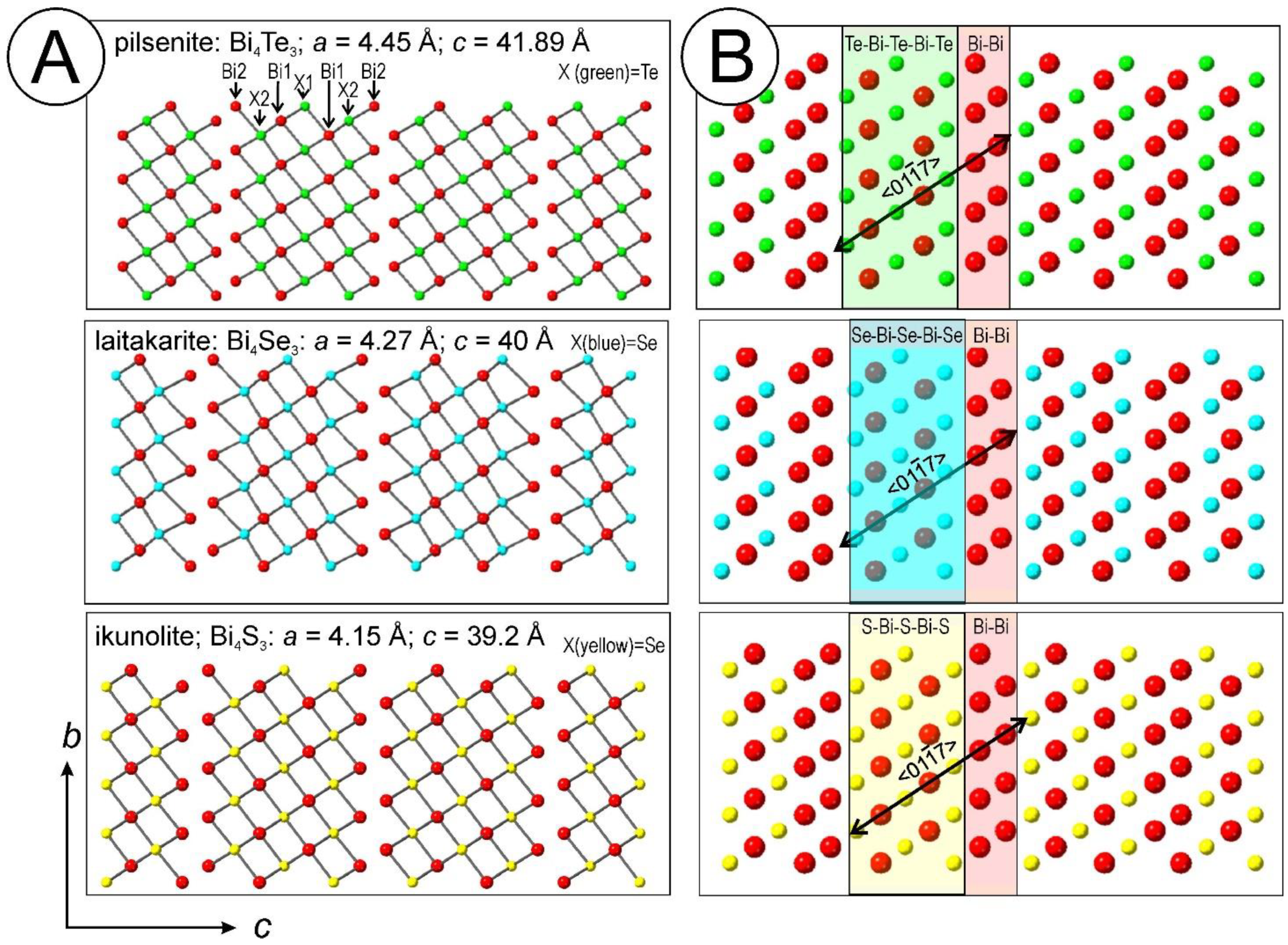
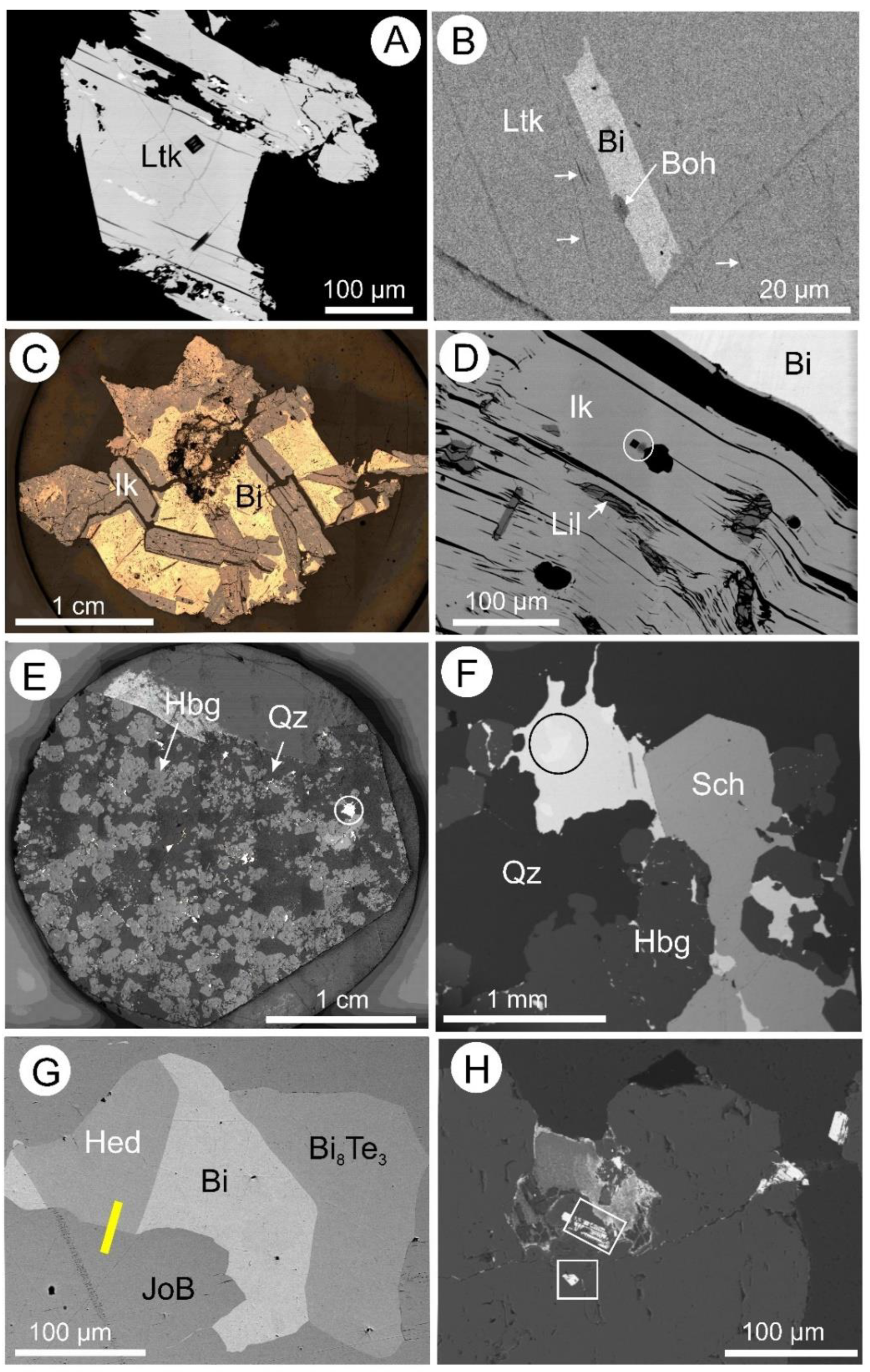
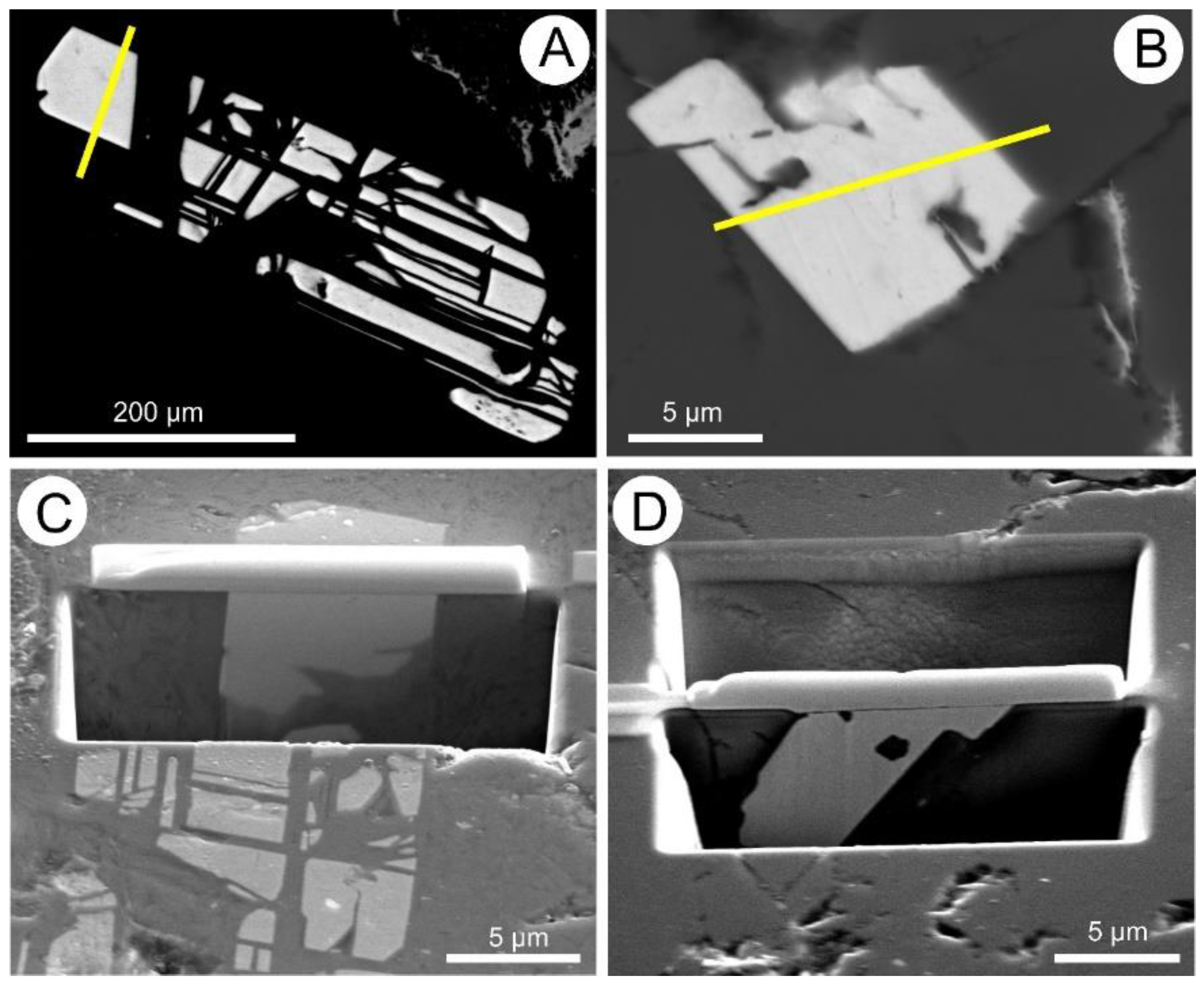
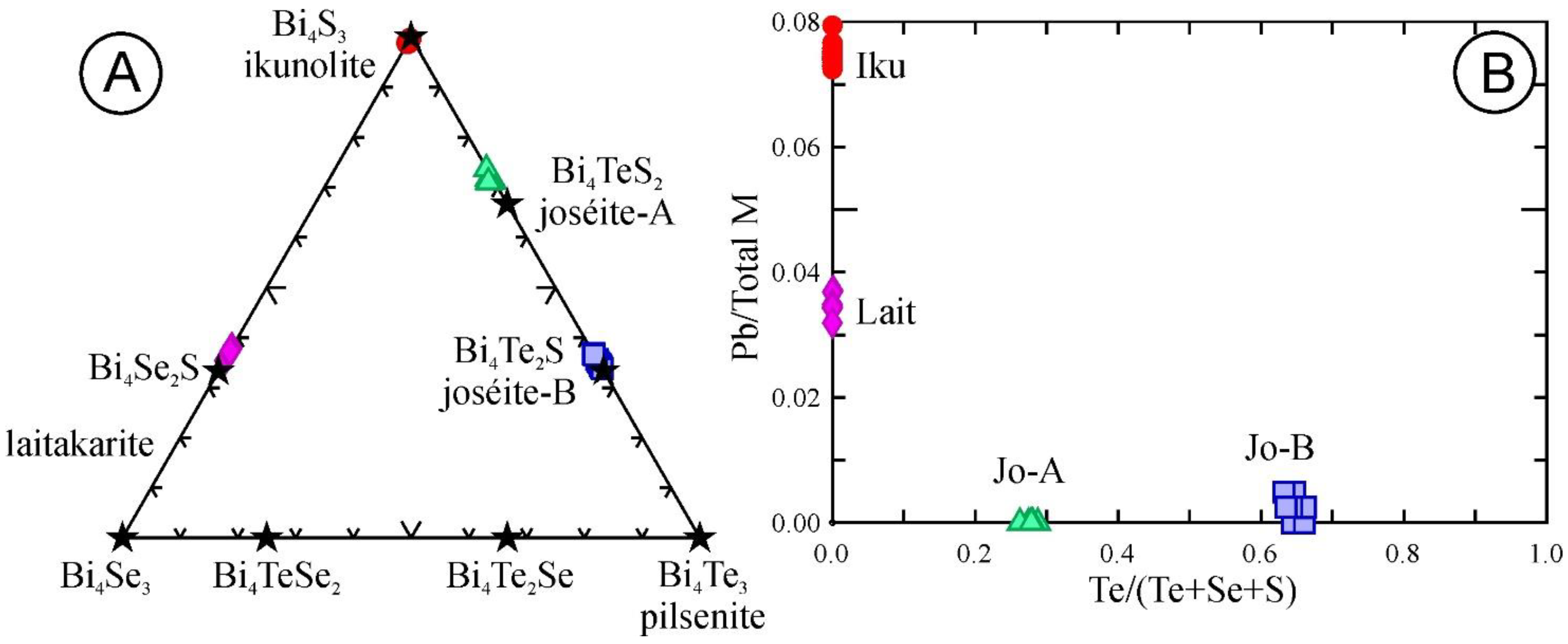
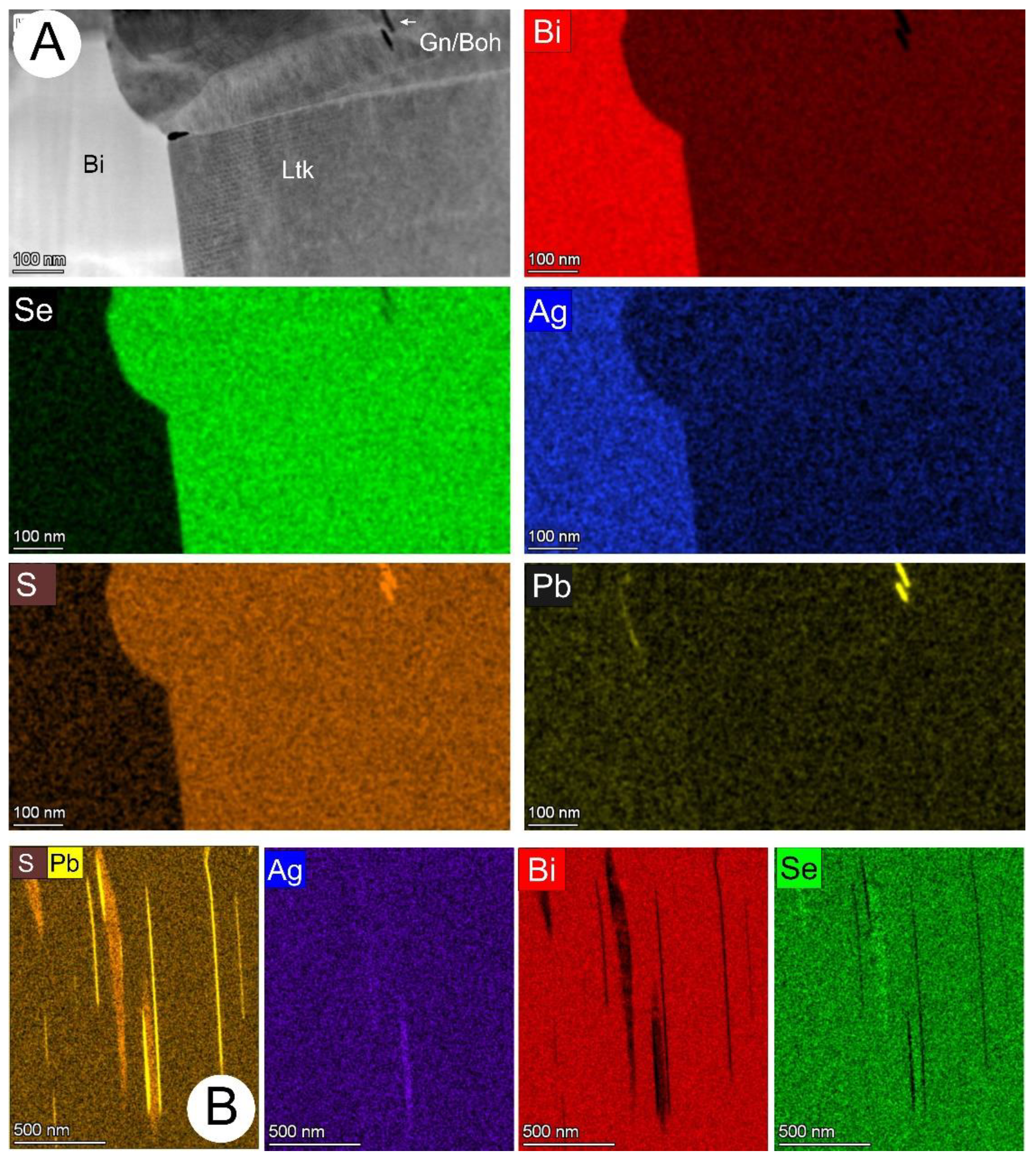
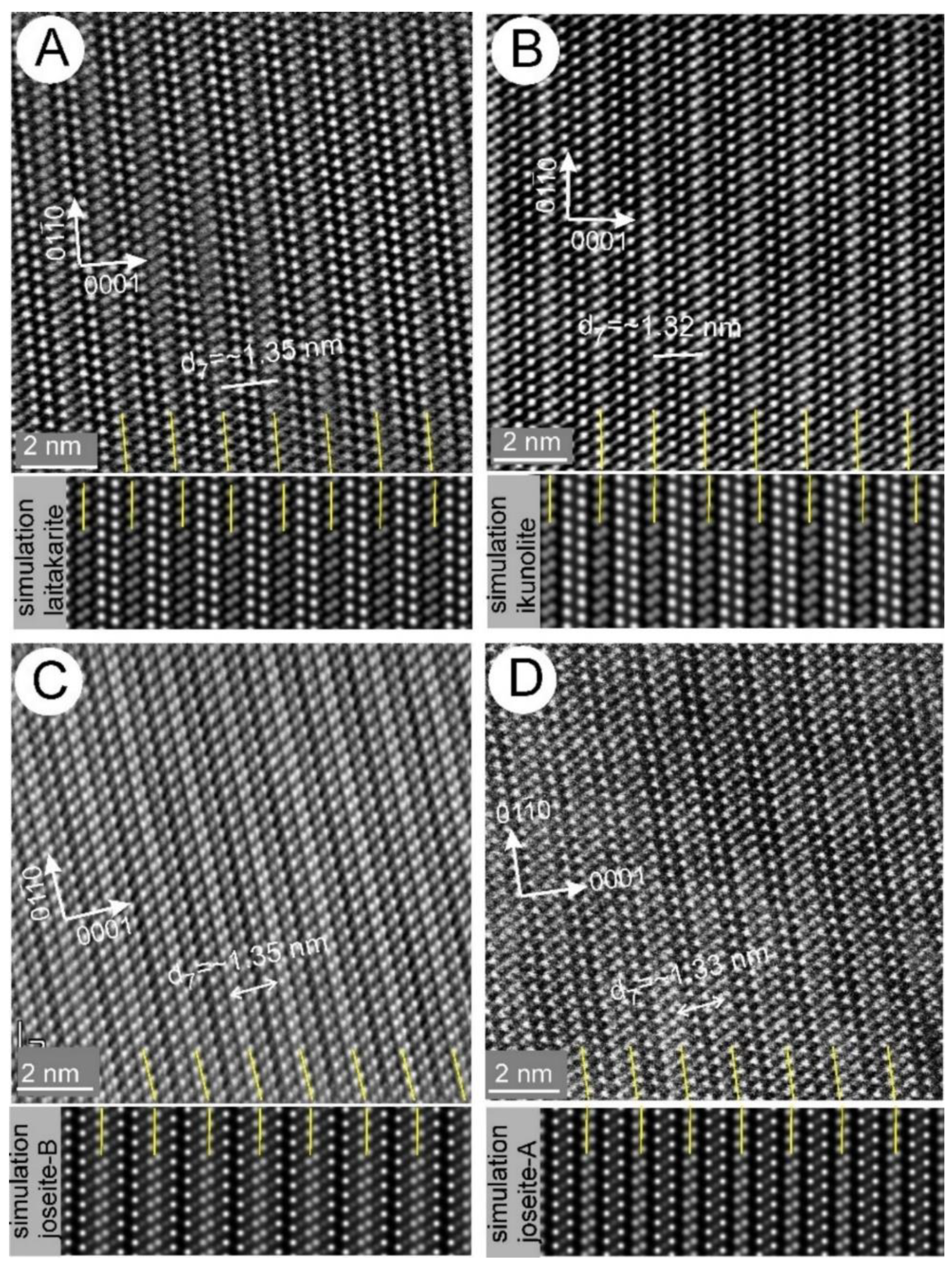

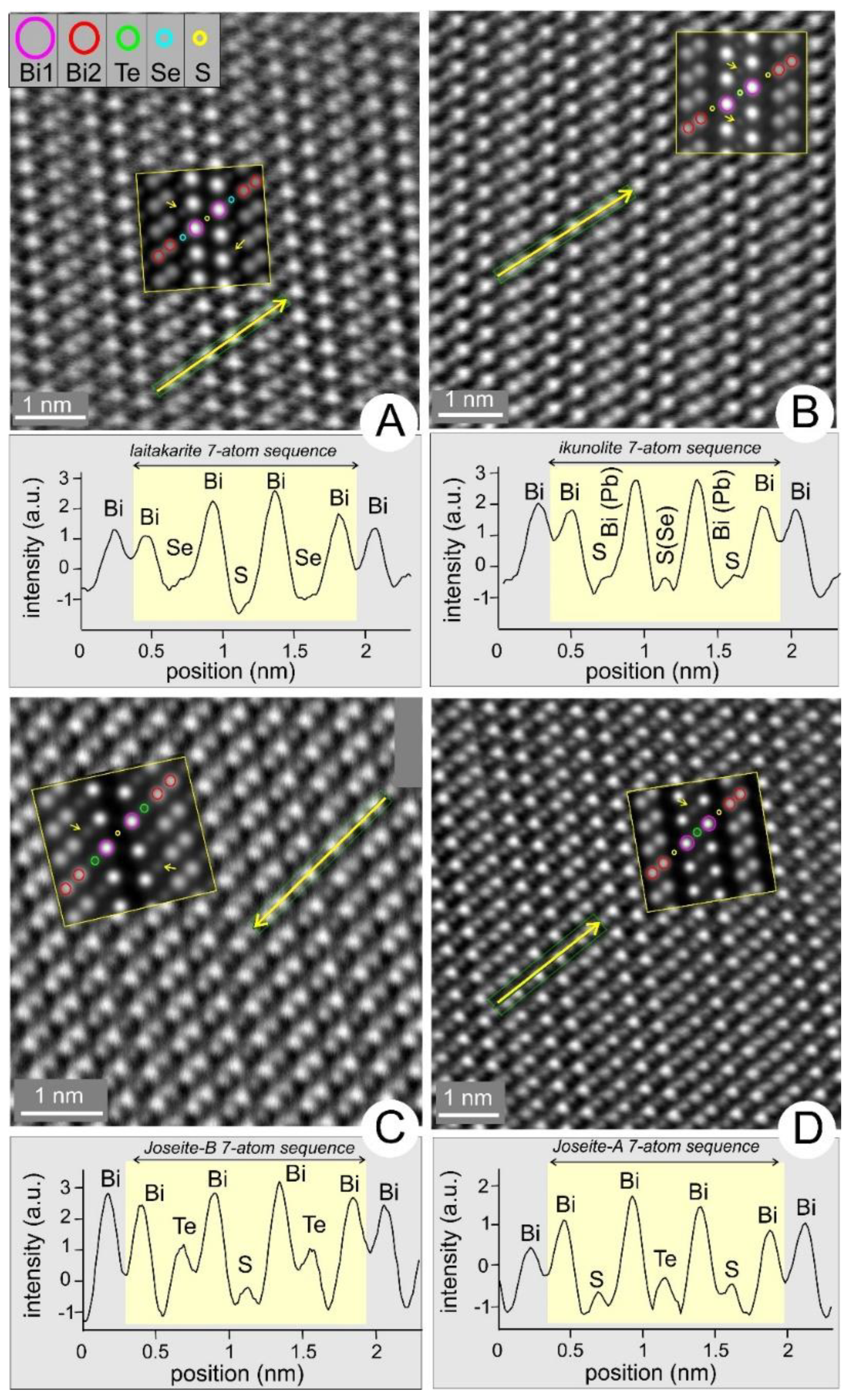
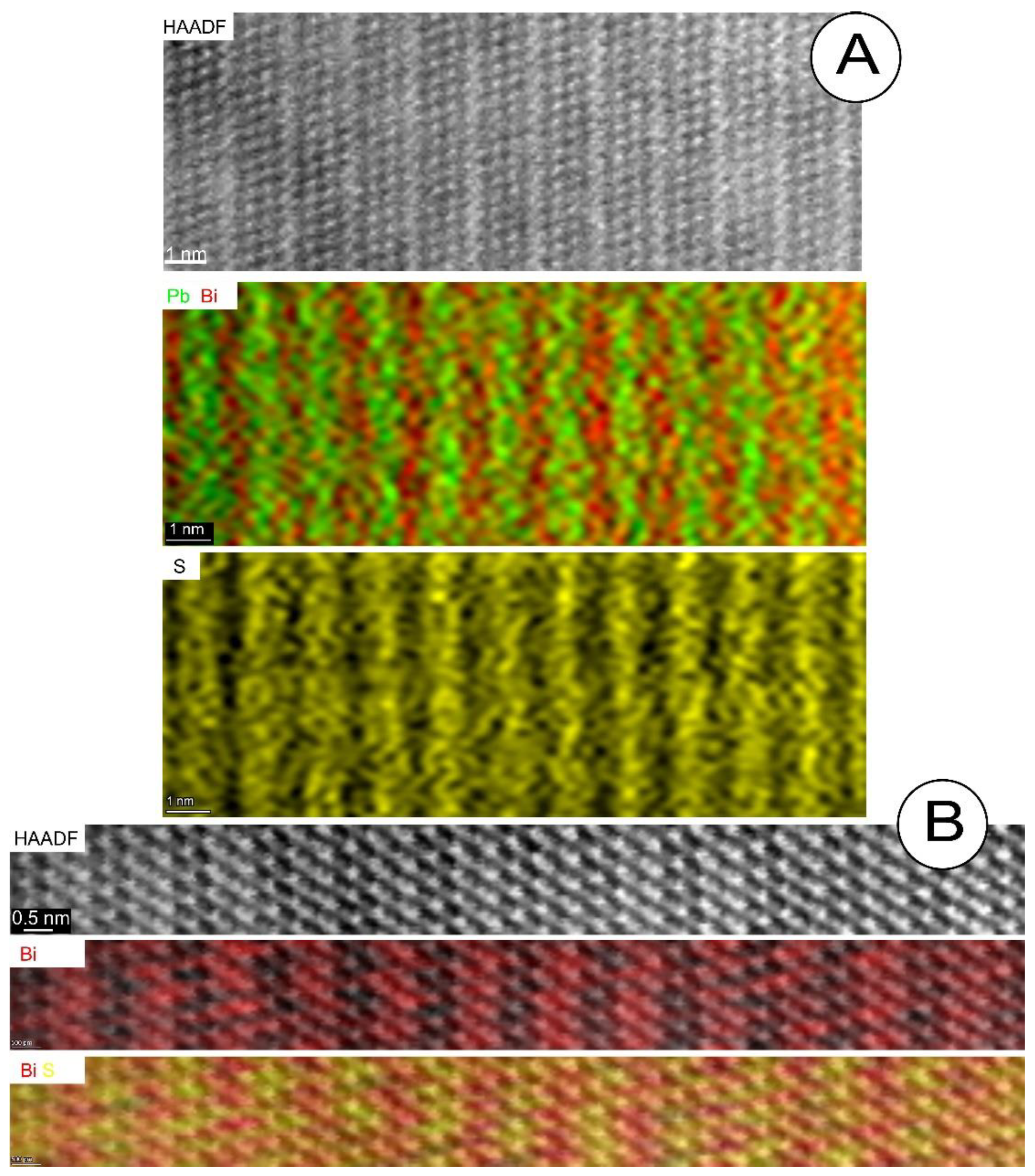
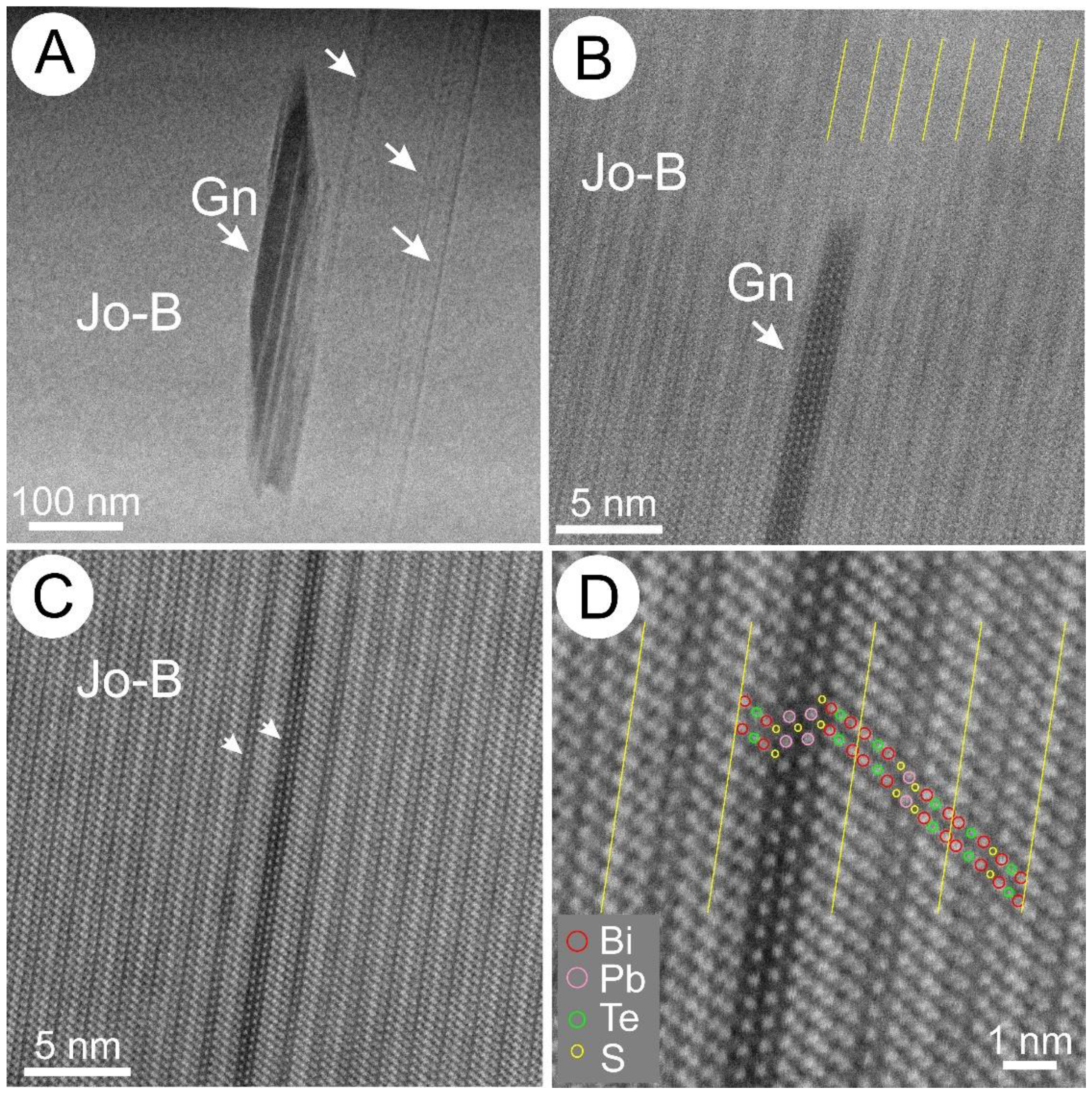
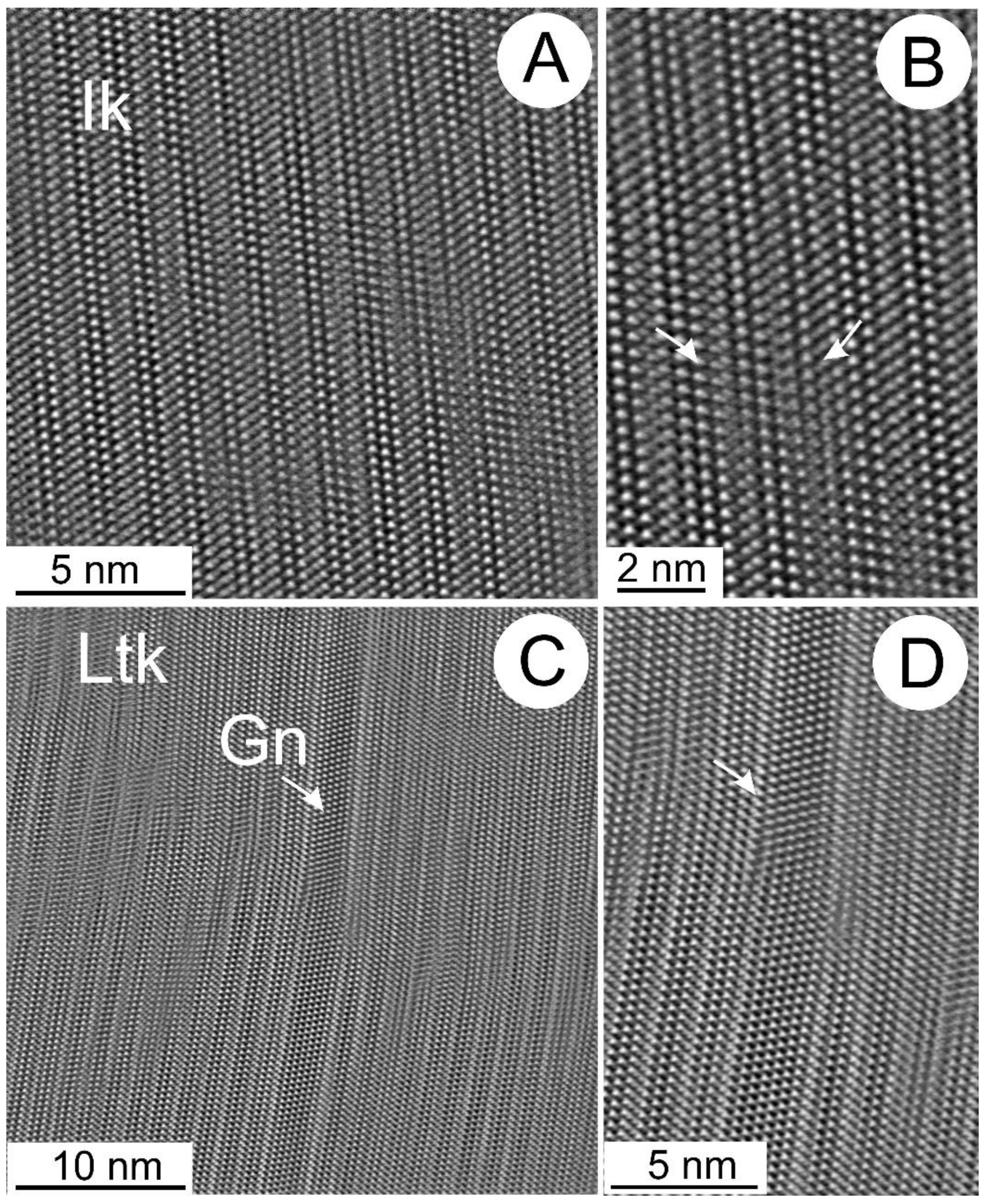
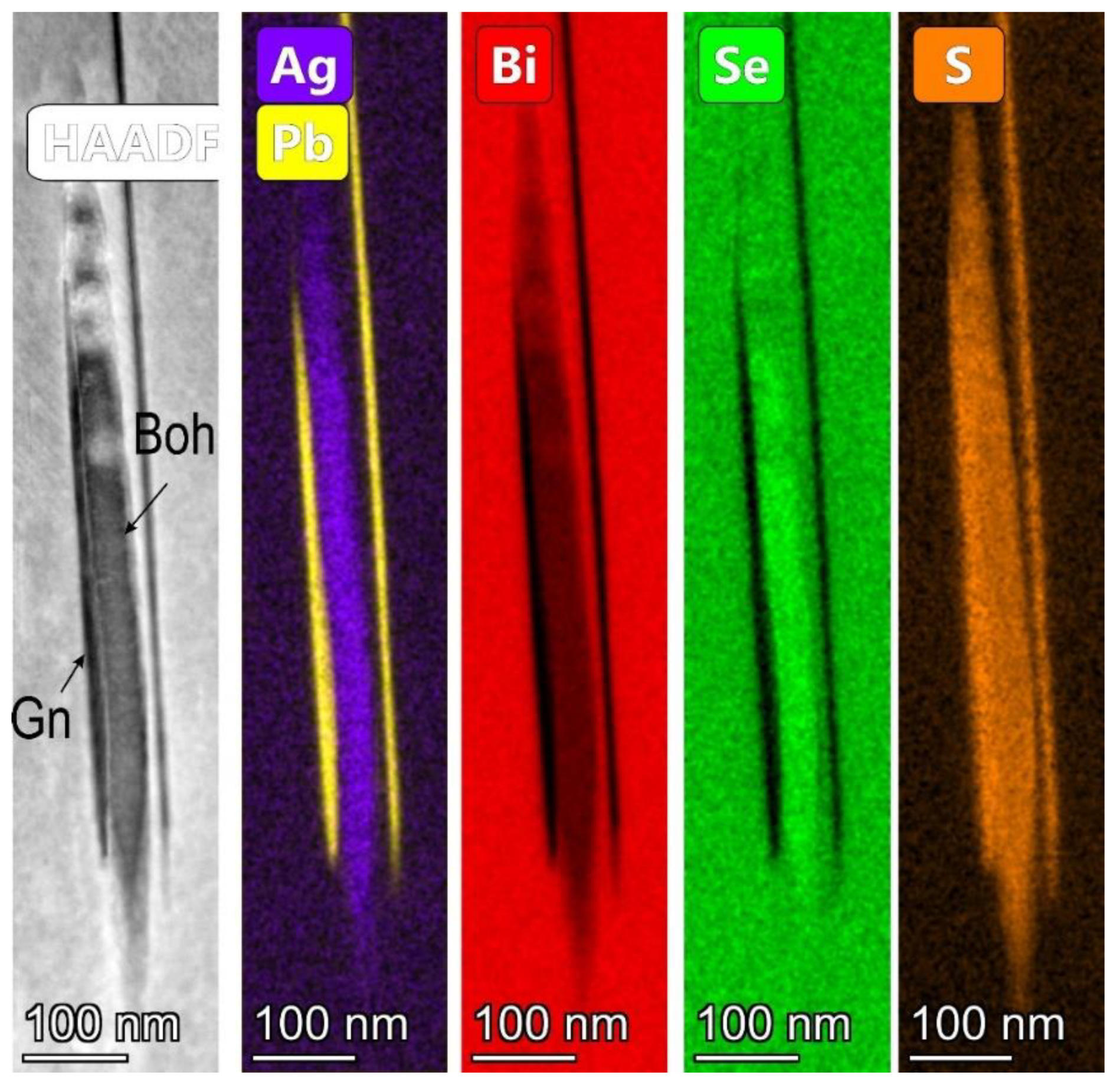
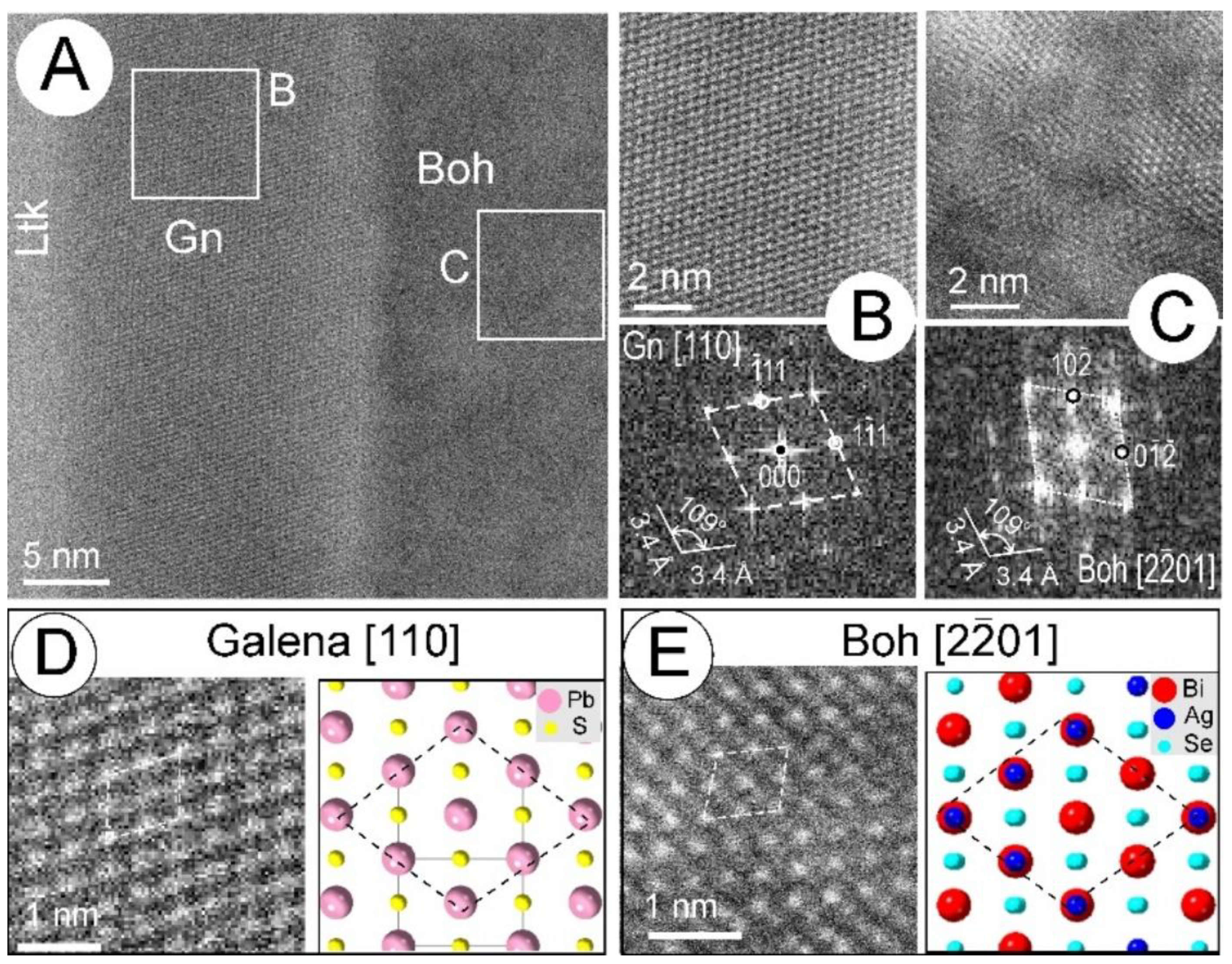
| Mineral | Specimen | Empirical Formula |
|---|---|---|
| Laitakarite | Orijärvi, Finland | (Bi3.93Pb0.14)4.07(Se1.84S1.09)2.93 |
| Ikunolite | Ashio, Japan | (Bi3.67Pb0.30)3.99(S2.99Se0.02)3.01 |
| Joséite-A | Hedley, B.C., Canada | Bi3.98(Te0.85Se0.01S2.17)3.02 |
| Joséite-B | (Bi4.08Pb0.01Sb0.01)4.10(Te1.89S1.01)3.90 |
| Mean (n = 10) | S.D. | Minimum | Maximum | |
|---|---|---|---|---|
| Pb | 2.85 | 0.12 | 2.59 | 3.01 |
| Bi | 80.28 | 0.74 | 79.20 | 81.47 |
| S | 3.43 | 0.06 | 3.32 | 3.49 |
| Se | 14.18 | 0.30 | 13.84 | 14.93 |
| Te | <mdl | 0.01 | 0.00 | 0.04 |
| Total | 100.74 | 0.81 | 99.30 | 102.01 |
| Pb | 0.141 | 0.006 | 0.128 | 0.148 |
| Bi | 3.928 | 0.024 | 3.878 | 3.953 |
| Sum Me | 4.069 | 0.022 | 4.018 | 4.090 |
| S | 1.094 | 0.017 | 1.054 | 1.115 |
| Se | 1.836 | 0.034 | 1.812 | 1.928 |
| Te | - | - | - | - |
| Sum S + Se + Te | 2.931 | 0.022 | 2.910 | 2.982 |
| Mean (n = 41) * | S.D. | Minimum | Maximum | Mean Au-Bearing (n = 9) ** | |
|---|---|---|---|---|---|
| Au | <mdl | 0.06 | <mdl | 0.23 | 0.13 |
| Zn | <mdl | 0.01 | <mdl | 0.05 | 0.01 |
| Cu | <mdl | 0.02 | <mdl | 0.08 | 0.01 |
| Ag | 0.06 | 0.06 | <mdl | 0.22 | 0.09 |
| Fe | <mdl | 0.01 | <mdl | 0.03 | <mdl |
| Cd | 0.04 | 0.04 | <mdl | 0.11 | 0.03 |
| Pb | 6.73 | 0.11 | 6.54 | 7.12 | 6.76 |
| Mn | <mdl | 0.01 | <mdl | 0.03 | <mdl |
| As | 0.01 | 0.03 | <mdl | 0.09 | 0.02 |
| Sb | 0.04 | 0.03 | <mdl | 0.08 | 0.02 |
| Bi | 83.79 | 0.37 | 83.03 | 84.50 | 83.96 |
| S | 10.46 | 0.10 | 10.20 | 10.63 | 10.45 |
| Te | <mdl | 0.00 | <mdl | <mdl | <mdl |
| Se | 0.20 | 0.05 | 0.12 | 0.30 | 0.23 |
| Total | 101.34 | 0.37 | 100.53 | 101.97 | 101.71 |
| Calculated formula (7 atom basis) | |||||
| Au | 0.001 | 0.003 | - | 0.011 | 0.006 |
| Zn | 0.001 | 0.002 | - | 0.006 | 0.001 |
| Cu | 0.001 | 0.002 | - | 0.012 | 0.001 |
| Ag | 0.005 | 0.005 | - | 0.018 | 0.008 |
| Pb | 0.297 | 0.005 | 0.289 | 0.317 | 0.298 |
| Fe | 0.000 | 0.001 | - | 0.005 | 0.000 |
| Mn | 0.000 | 0.001 | - | 0.005 | 0.000 |
| Cd | 0.003 | 0.003 | - | 0.009 | 0.003 |
| Bi | 3.674 | 0.022 | 3.641 | 3.733 | 3.673 |
| As | 0.001 | 0.003 | - | 0.010 | 0.002 |
| Sb | 0.003 | 0.002 | - | 0.006 | 0.002 |
| Sum Me | 3.987 | 0.019 | 3.951 | 4.030 | 3.993 |
| S | 2.990 | 0.021 | 2.949 | 3.029 | 2.980 |
| Te | - | - | - | - | 0.000 |
| Se | 0.024 | 0.006 | 0.014 | 0.035 | 0.027 |
| Sum S + Se + Te | 3.013 | 0.019 | 2.970 | 3.049 | 3.007 |
| Joséite-B (Bi4Te2S) (n = 20) | Joséite-A (Bi4TeS2) (n = 7) | ||||||||
|---|---|---|---|---|---|---|---|---|---|
| Mean | S.D. | Minimum | Maximum | Representative | Mean | S.D. | Minimum | Maximum | |
| Pb | 0.20 | 0.08 | 0.00 | 0.36 | - | - | - | - | - |
| Bi | 76.57 | 0.45 | 75.58 | 77.21 | 82.31 | 81.77 | 0.42 | 81.07 | 82.31 |
| Sb | 0.07 | 0.06 | <mdl | 0.16 | - | - | - | - | - |
| Te | 21.61 | 0.37 | 20.94 | 22.19 | 10.73 | 10.96 | 0.30 | 10.67 | 11.42 |
| Se | <mdl | - | - | - | 0.08 | 0.15 | 0.10 | 0.03 | 0.27 |
| S | 2.91 | 0.09 | 2.77 | 3.09 | 6.88 | 7.12 | 0.22 | 6.88 | 7.52 |
| Total | 101.36 | 0.44 | 100.10 | 101.95 | 100.00 | 100.00 | - | - | - |
| Formula on basis of 7 atoms | Formula on basis of 7 atoms | ||||||||
| Pb | 0.01 | 0.00 | 0.00 | 0.02 | 0.00 | - | - | - | - |
| Bi | 4.08 | 0.02 | 4.04 | 4.13 | 3.98 | 3.91 | 0.05 | 3.84 | 3.98 |
| Sb | 0.01 | 0.01 | 0.00 | 0.01 | 0.000 | 0.00 | 0.00 | 0.00 | 0.00 |
| Sum Me | 4.10 | 0.02 | 4.07 | 4.14 | 3.98 | 3.91 | 0.05 | 3.84 | 3.98 |
| Te | 1.89 | 0.03 | 1.82 | 1.93 | 0.85 | 0.86 | 0.02 | 0.82 | 0.89 |
| Se | - | - | - | - | 0.010 | 0.02 | 0.01 | 0.00 | 0.03 |
| S | 1.01 | 0.03 | 0.97 | 1.07 | 2.166 | 2.22 | 0.05 | 2.17 | 2.31 |
| Sum Te + Se + S | 2.90 | 0.02 | 2.86 | 2.93 | 3.02 | 3.09 | 0.05 | 3.02 | 3.16 |
Publisher’s Note: MDPI stays neutral with regard to jurisdictional claims in published maps and institutional affiliations. |
© 2021 by the authors. Licensee MDPI, Basel, Switzerland. This article is an open access article distributed under the terms and conditions of the Creative Commons Attribution (CC BY) license (https://creativecommons.org/licenses/by/4.0/).
Share and Cite
Cook, N.J.; Ciobanu, C.L.; Slattery, A.D.; Wade, B.P.; Ehrig, K. The Mixed-Layer Structures of Ikunolite, Laitakarite, Joséite-B and Joséite-A. Minerals 2021, 11, 920. https://doi.org/10.3390/min11090920
Cook NJ, Ciobanu CL, Slattery AD, Wade BP, Ehrig K. The Mixed-Layer Structures of Ikunolite, Laitakarite, Joséite-B and Joséite-A. Minerals. 2021; 11(9):920. https://doi.org/10.3390/min11090920
Chicago/Turabian StyleCook, Nigel John, Cristiana L. Ciobanu, Ashley D. Slattery, Benjamin P. Wade, and Kathy Ehrig. 2021. "The Mixed-Layer Structures of Ikunolite, Laitakarite, Joséite-B and Joséite-A" Minerals 11, no. 9: 920. https://doi.org/10.3390/min11090920
APA StyleCook, N. J., Ciobanu, C. L., Slattery, A. D., Wade, B. P., & Ehrig, K. (2021). The Mixed-Layer Structures of Ikunolite, Laitakarite, Joséite-B and Joséite-A. Minerals, 11(9), 920. https://doi.org/10.3390/min11090920







